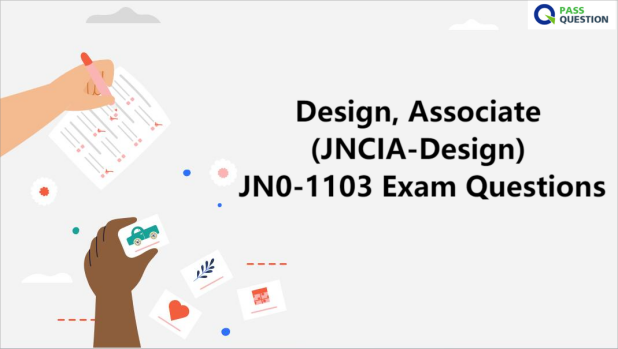Design, Associate (JNCIA-Design) JN0-1103 Exam Questions
When it comes to preparing for the Juniper JN0-1103 exam, it is crucial to have a comprehensive study plan and access to the necessary resources. PassQuestion understands the importance of this and offers the latest Design, Associate (JNCIA-Design) JN0-1103 Exam Questions that are designed to cover all the objectives of the exam, ensuring that you have a thorough understanding of the subject matter. By utilizing these Design, Associate (JNCIA-Design) JN0-1103 Exam Questions, you will be well-equipped to confidently pass your exam and achieve your certification.

Design, Associate (JNCIA-Design)
The Design track allows you to showcase your proficiency in applying Juniper Networks design principles and related technologies. JNCIA-Design, which is the entry-level certification in this track, has been specifically developed for networking professionals and designers who possess basic knowledge of network design, theory, and industry best practices. The written exam serves to validate your comprehension of the fundamental aspects of network design, ensuring that you have a solid foundation in this area.
Exam Information
Exam Code: JN0-1103
Prerequisite Certification: None
Delivered by: Pearson VUE
Exam Length: 90 minutes
Exam Type: 65 multiple-choice questions
Exam Topics
Customer Network Design Requirements
Securing the Network
Network Management or Reliability
Campus and Branch LAN Design
Campus and Branch WAN Design
Data Center Network Design
View Online Design, Associate (JNCIA-Design) JN0-1103 Free Questions
1. In which two situations does physical device redundancy make sense in a network design? (Choose two.)
A. When zero impact to users and applications is required during device failures.
B. When device failures in the customer's WAN provider are a possibility.
C. When downtime is not acceptable for device upgrades.
D. When server load in the DMZ is a is higher than normal.
Answer: A, C
2. You must design a campus that involves Ethernet switches that will be using Cat 6 copper cables. What is the maximum distance between the Ethernet switches?
A. 100 feet
B. 1000 feet
C. 100 meters
D. 1000 meters
Answer: C
3. What are the last two steps of business continuity planning? (Choose two.)
A. know your network
B. test the plan
C. formulate the plan
D. assess the risks
Answer: B, C
4. The business continuity RFP element contains which two requirements? (Choose two.)
A. Wired connection requirements
B. Traffic requirements
C. Network efficiency requirements
D. QoS requirements
Answer: C, D
5. You are the network architect with a large banking institution with operations around the world. Any outage results in lost revenue for your company, and may result in lost customers. Network uptime is your top priority.
What should be your focus?
A. return on investment
B. capacity planning
C. business continuity
D. service virtualization
Answer: C
6. Junos Space Security Director is an example of which type of network management solution?
A. on-box
B. op script
C. event script
D. centralized
Answer: D
7. What is the second step of the Juniper recommended executive summary structure of an RFP?
A. Identification of business benefits.
B. Relevant supporting information outlining why the customer should choose your plan.
C. Overview of your proposed solution.
D. Introduction of the customer's need or problem.
Answer: A
8. Connectivity issues have been seen by the users in remote offices when attempting to access resources at the corporate headquarters. You must design a fix for these issues. Which technology should you include in your design?
A. hub-and-spoke VPN
B. auto-discovery VPN
C. redundant WAN links
D. accelerated WAN links
Answer: C
9. Which design boundary is caused by the customer's existing physical environment?
A. Marketing users are not permitted access to the company's financial servers.
B. Current infrastructure lacks the media to interconnect buildings with each other.
C. Key stakeholders disagree on how the funding for the project should be spent.
D. HTTP traffic is expected to increase on the network by 57% over the next two years.
Answer: B
10. What should be the fourth item in your network design checklist?
A. A process for selecting protocols, address schemes, naming conventions, and so forth.
B. A validation process for analyzing customer's existing environment.
C. A process for understanding the customer's business and technical goals.
D. The steps for designing a network topology.
Answer: A
- TOP 50 Exam Questions
-
Exam
All copyrights reserved 2025 PassQuestion NETWORK CO.,LIMITED. All Rights Reserved.

